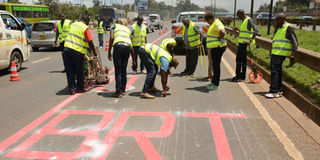BRT system delayed as Kenya opts for local suppliers

Lanes are set aside for high-quality buses on Thika Superhighway, on April 5, 2018. Implementation of the system has been derailed. PHOTO | FILE | NATION MEDIA GROUP
What you need to know:
- The Ministry’s rush to import the buses was put on hold after it emerged that the procurement process had not been fully complied with.
- Under the initial plan, Kenya was to build special lanes on Haile Selassie Avenue, Moi Avenue, Kenyatta Avenue and University Way.
The government has extended the bidding period for the controversial tender to build infrastructure for high-capacity buses to decongest Nairobi, even as buses ordered from South Africa rot in a waiting yard.
The Housing and Urban Development department and the Nairobi Metropolitan Area Transport Authority (Namata) on Monday extended the tender to design and build the Bus Rapid Transit (BRT) facilities on Thika Road.
“Following the pre-bid site visit held on December 17, 2019, the submission date for the above tender has been extended to January 27, 2020,” the notice by Namata acting director-general read in part.
The Nation has learnt that the Ministry of Transport’s rush to import the buses was put on hold after it emerged that the procurement process had not been fully complied with.
The other hitch was lack of supporting infrastructure for the buses other than road markings.
TENDER WARS
Local manufacturers also threw the plan into a spin when they protested being overlooked by the ministry, which awarded the tender to a foreign entity yet they had the capacity to carry out the task.
The irony was that as Kenya was looking at buying from South Africa, Kenyan manufacturers were getting orders to assemble such buses for the regional markets.
Before the process was hit by procurement headwinds, the Treasury had allocated Sh5.53 billion to be used in the construction of special lanes for the high-capacity buses.
By May last year, the South African firm that had been contracted to supply the buses had almost completed the first batch of 64 buses, which were later cut by half after local manufacturers protested.
The buses were painted yellow and blue with the name Namata on the sides, ready for shipment.
TANZANIA LEADS
They have priority seats for disabled passengers and clearly marked areas for sitting and standing commuters.
One of the buses whose pictures were leaked showed that it was certified to carry 36 sitting passengers and 52 standing ones, and it had one wheelchair bay.
As they were being painted, the ministry was busy painting the lanes on Thika Road in readiness for their arrival.
But that was the last time the process was heard of, as the ministry was forced back to the drawing board.
Under the initial plan, Kenya was to build special lanes on Haile Selassie Avenue, Moi Avenue, Kenyatta Avenue and University Way.
Outside the central business district, Namata mapped out five routes — Thika Road, Jogoo Road, Mombasa Road and Outer Ring Road — that will have lanes reserved for the buses.
In 2016, Dar es Salaam became the first city in East Africa to launch a BRT system, which has helped ease public transport.
LOCAL INDUSTRIES
Dar completed the first phase of the 21km rapid transit system, which has five terminals, 27 stations, seven feeder and three connector stations. About 140 buses use it daily.
It is not clear if Kenya has already cancelled the tender for the South African manufacturer.
Besides boosting the local industry and the 'Buy Kenya, Build Kenya' initiative, buying locally would make serving, repairing and maintaining the buses easier.





